Quizzes with Canvas: Online Econometrics, Day 12.5
During the last month, my TA and I have created quizzes for all 13 modules in the class. Each quiz is made up of 10-15 multiple choice questions that test whether the student is absorbing the main points of the video lectures. The students get practice applying and combining the concepts with more difficult exercises in their homework. I think the quizzes have been successful, although with just 8 students in the class it’s hard to tell for sure.







